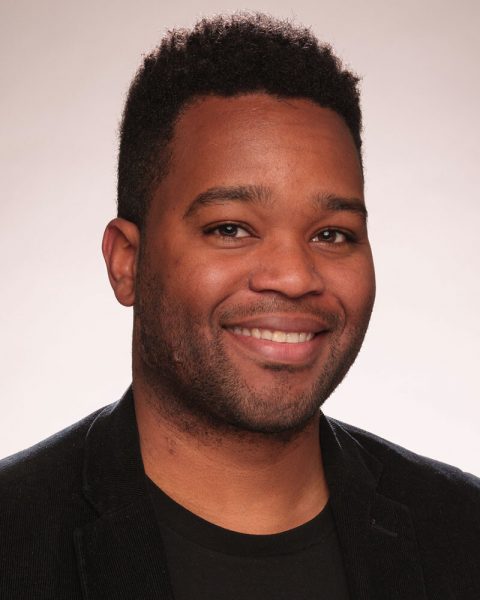By Jenna Somers

Deon Benton, assistant professor of psychology and human development, is leading an experimental study to understand when and how infants learn to distinguish that people can cause action both from a distance and by contact, but objects can only cause action by contact. While this knowledge is generally held to be innate—that is, unlearned and possibly present from birth—Benton theorizes that infants develop knowledge about the causal actions of people and objects through associative learning. Understanding when and how infants acquire knowledge about causal action could advance the field of human development and inform caregivers’ interactions with infants.
Supported by a $158,000 grant from the National Institute of Child Health and Human Development, Benton will test the associative learning theory with 4-, 7-, and 11-month-old infants to understand when and how babies develop knowledge about the causal actions of people and objects. Benton expects that through these experiments, he will replicate findings from his proof-of-concept paper, recently published by the Proceedings of the Annual Meeting of the Cognitive Science Society, in which he used neural network computer simulations to demonstrate that infants understand causal actions through associative learning.
“Associative learning is about the way people—including babies—attend to the regularities in their environment,” said Benton, director of the Computational Cognitive Development Laboratory at Vanderbilt Peabody College of education and human development. “Babies might first develop an understanding that the world consists of people and objects and that action can occur from contact or no contact. They then might notice a common feature associated with the ability to cause action at a distance or by contact—that feature could be legs, arms, the face, etc.—and that lacking that feature is associated with the ability to only cause action by contact. From there, babies might associate a whole person and their features, and a whole object and its features. As babies continue to develop, they then might associate all people with the ability to cause action at a distance and by contact, and all objects as having the ability to only cause action by contact.”
In the study with infants, Benton will recreate the neural network experiments. Importantly, if the results of the experiment with infants and the computer model are similar, they may advance the field’s understanding of infant development and inform expectations of how infants can interact in their environments at different developmental stages.
To understand the development of associative learning in babies, Benton’s lab will first recreate an often-cited, though never-published, study by Elizabeth Spelke, a renowned developmental scientist, that sought to demonstrate innate knowledge of causal action in 7-month-olds. In Benton’s version, infants will watch videos of cartoon people and videos of cartoon objects as members from Benton’s lab measure their “looking times.” “Looking time”—how long a baby stares at something—is a standard measure to help understand how babies learn new information. The babies will either watch three sets of people videos or three sets of object videos:
- Video one: person/object enters the screen, moves toward another person/object who’s partially covered by a curtain, and then the other person/object exits the screen.
- Video two: person/object enters the screen, touches the other person/object who then exits the screen.
- Video three: person/object enters the screen, advances toward but does not touch the other person/object who then exits the screen.
“The idea is that if babies’ knowledge about causal action is innate then their looking times, no matter their age, should be much longer when the objects move by themselves versus on contact because they would know objects can’t move by themselves. Their looking times for the people scenarios should be about evenly split because the babies would know that people can cause action through contact and at a distance,” Benton said.
After Benton recreates the original study with 7-month-olds, he will show the videos to 4-month-olds. “If my theory is correct, that babies acquire this knowledge, you might expect that 4-month-old babies would not be surprised that objects move by themselves compared to objects that move when contacted because they haven’t acquired enough experience with objects to learn that. Testing at 4, 7, and 11 months old allows us to see whether there is a developmental progression toward understanding causal action,” Benton said.
If Benton can demonstrate that babies learn about causal action as they develop, then, for him, the more interesting question is how they learn it. To help answer that question, infants will view the original sequence of videos with modified people and modified objects in which the bottom half of people and objects are reversed, so that people have object bottoms, rather than legs, and objects have legs, rather than object bottoms. In these experiments, Benton will assess whether babies learn to associate certain features, such as legs, with the ability to cause action at a distance and by contact. The babies might come to realize that things with legs tend to move by themselves, whereas things without legs generally don’t. Benton theorizes that if babies are learning by association, then at some point in their development, they should be surprised when the modified person (top half person/bottom half object) moves on its own, and unsurprised when the modified object (top half object/bottom half legs) moves on its own, because they will have learned to associate legs with independent movement.
Benton also will try to decipher which feature(s) infants are associating with causal action at a distance by reversing a variety of people and object features; it might be that the babies associate another or a combination of human features with causal action at a distance.
If Benton’s study can reveal when and how infants begin to understand causal action in people and objects, that knowledge could ultimately support caregiver interactions and expectations for how infants are able to engage with their environment.
